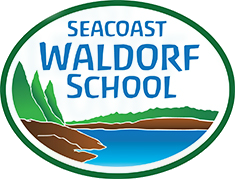Special Subjects
At Seacoast Waldorf School, a mix of artistic and movement-based subjects balance the school day, pairing creativity with academic learning for a truly holistic education. Some of our special subjects include music, physical education, woodwork, foreign language, and handwork.
World Languages
Starting in first grade, Seacoast students learn two foreign languages, Spanish and German. Grades one through three become acquainted with the cultures behind these languages, through story, music, and movement, as well as the vocabulary and cadences of language. Grade four adds reading and grammar into the mix, which continues in depth and rigor through middle school. Seacoast Waldorf students learn more than language, though. Students experience the culture behind a language, including food, festivals, and dance. Classes often present short plays, songs, and poems in Spanish or German at school assemblies.
Handwork
Seacoast Waldorf students work on physical coordination from a young age, increasing the challenges of coordinating hands, limbs, and mind as the children mature. This motivates development and intellect and academic capacities as a child’s body becomes more skilled. Handwork is a special feature of Waldorf Education which is taught in all grades. From finger-knitting to embroidery, cross-stitch, and crochet, to even more challenging projects in middle school that involve the use of sewing machines and other tools, Handwork gives children an opportunity to create a project from their hands and feel a true sense of accomplishment. Plus, Handwork builds practical skills that Seacoast students take with them into life.
Handwork offers more than simple art projects, though. Mathematical concepts such as parallelism, mirror-imaging, progression, and geometric forms are interwoven with this tactile learning process. There is also the aesthetic experience of creating something beautiful that nourishes a child’s emotional sensibilities and builds self-confidence. In first grade, students learn to knit. Second through fifth grades introduce crochet, cross-stitch, embroidery, and knitting in the round. By sixth grade, as students approach adolescence, they sew three-dimensional animals or dolls. Seventh grade features show-making or other practical work, and the culmination of the Handwork curriculum arrives in eighth grade while students study the Industrial Age. Learning to use a sewing machine, the students make clothing or quilts. Projects are always of a practical nature: potholders, cushions, toys, hats, socks, shoes, and articles of clothing, which become mementos of their education and of their unique capabilities.
Movement / Games
At Seacoast Waldorf School, the Movement and Games curriculum cultivates coordination and movement skills that are the precursors to formal organized sports. Our Movement curriculum grows from the belief that spatial awareness and intelligence as well as the joy of physical movement are essential components for a full and balanced life. Movement activities include imaginative and strategic games, obstacle courses, and for the older grades, competitive games. Foremost is an experience of freedom in play while children develop skills. Students learn to play with others before they play against an opponent.
Music
Music is an integral part of everything we do at Seacoast Waldorf School. Singing is a fixture in all classrooms and programs. By first grade, students learn more formal approaches to singing and recorder playing as part of the curriculum, and general music classes bring greater focus to the musicality of the school day. By third grade, chorus invites students to build formal techniques and repertoire related to the curriculum, and fourth grade, presents students with the opportunity to play a stringed instrument. Periodic school assemblies, concerts, and seasonal celebrations give students an opportunity to perform what they have learned before the school community.
Arts
Drama, painting, drawing, modeling, and coordinated movement are integrated into every aspect of the academic curriculum. Students learn to illustrate complicated logarithmic spirals through precise drawing with a compass. The pyramids of Egypt may be modeled in clay, the mythological characters of ancient Greece depicted in watercolor paintings and the music of Medieval Europe performed on a recorder. Class plays relate to themes of the Main Lesson. First-grade students act out fairy tales and nature stories, while eigth graders might perform Shakespeare. Plus, starting with first grade, students fill Main Lesson books with drawings, illustrations, and beautiful handwriting to depict what they learn in every academic subject block of the year. These original textbooks are a testimony to each student’s artistic and academic endeavors, and they become cherished keepsakes that students take home at year-end and treasure for years to come.
Woodwork
Students in fifth through eighth grades learn woodworking, using tools to rasp, file, gouge, and plane. They learn to appreciate the life-imbued medium of wood, creating a sequence of useful objects such as spoons, bowls, and three-legged stools. These lessons teach students the fundamentals of sculptural form and build a sense of confidence in their ability to work with their hands to make things of practical, immediate use.
Clay hieroglyphics.
Cross country skiing in Movement Class.



